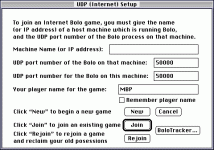Scott Squires
Well-known member
Well the greater issue I see is that each client contacts another client, so everyone connecting needs to be reachable by everyone else.
If it really does this "ring" method described in the dissertation, I'm not sure how a server would have been possible. It makes sense for an AppleTalk network. But hopefully a different protocol was introduced when UDP support was added. Looking forward to hearing your findings after you get a test network set up.




